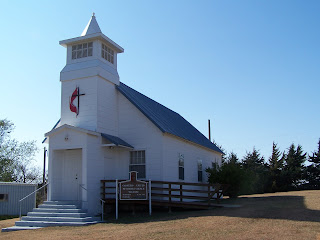CARNEIRO - The bells of the steeple chime in parishioners every Sunday morning at the little white church in this rural Kansas town.
And it seems it doesn't matter that the school closed years ago or that fewer than a half-dozen residents live here. Pastor Steve Holmes continues to bring a message to his 20-some-member Carneiro United Methodist Church congregation each Sunday - just as other ministers did for 125 years.
"Kansas, like the commercials say, gives you a sense of wide-open spaces," he said, noting that this ghost town of sorts "doesn't have the hustle and bustle of the city.
"I just think it's closer to God that way," he said.
Take a drive through the Smoky Hills past Kanopolis Reservoir and the Ellsworth County town of Carneiro suddenly appears amid the sloping terrain along K-140. These days, all that's left of the once-prosperous sheep shipping point are a few homes, the boarded-up school, a dilapidated general store and the well-manicured church.
Yet, the little town still has a pulse thanks, in part, to the weekly church services, as well as a monthly community potluck in the church's small addition. The town is also a tourist stop for those visiting Kanopolis Reservoir, and recent local lore suggests the area might have buried treasure connected to the notorious outlaw Jesse James.
And it seems it doesn't matter that the school closed years ago or that fewer than a half-dozen residents live here. Pastor Steve Holmes continues to bring a message to his 20-some-member Carneiro United Methodist Church congregation each Sunday - just as other ministers did for 125 years.
"Kansas, like the commercials say, gives you a sense of wide-open spaces," he said, noting that this ghost town of sorts "doesn't have the hustle and bustle of the city.
"I just think it's closer to God that way," he said.
Take a drive through the Smoky Hills past Kanopolis Reservoir and the Ellsworth County town of Carneiro suddenly appears amid the sloping terrain along K-140. These days, all that's left of the once-prosperous sheep shipping point are a few homes, the boarded-up school, a dilapidated general store and the well-manicured church.
Yet, the little town still has a pulse thanks, in part, to the weekly church services, as well as a monthly community potluck in the church's small addition. The town is also a tourist stop for those visiting Kanopolis Reservoir, and recent local lore suggests the area might have buried treasure connected to the notorious outlaw Jesse James.
 |
| Carneiro Cemetery is about a mile west of town |
 |
| This is one of E.W. Wellington's homes, a prom. Ellsworth County rancher, biz man |
 |
| One of the general stores still stands, complete with old display cases, collections and junk filling the inside, but Sneath wasn't sure if it was the one his ancestor ran. |









No comments:
Post a Comment